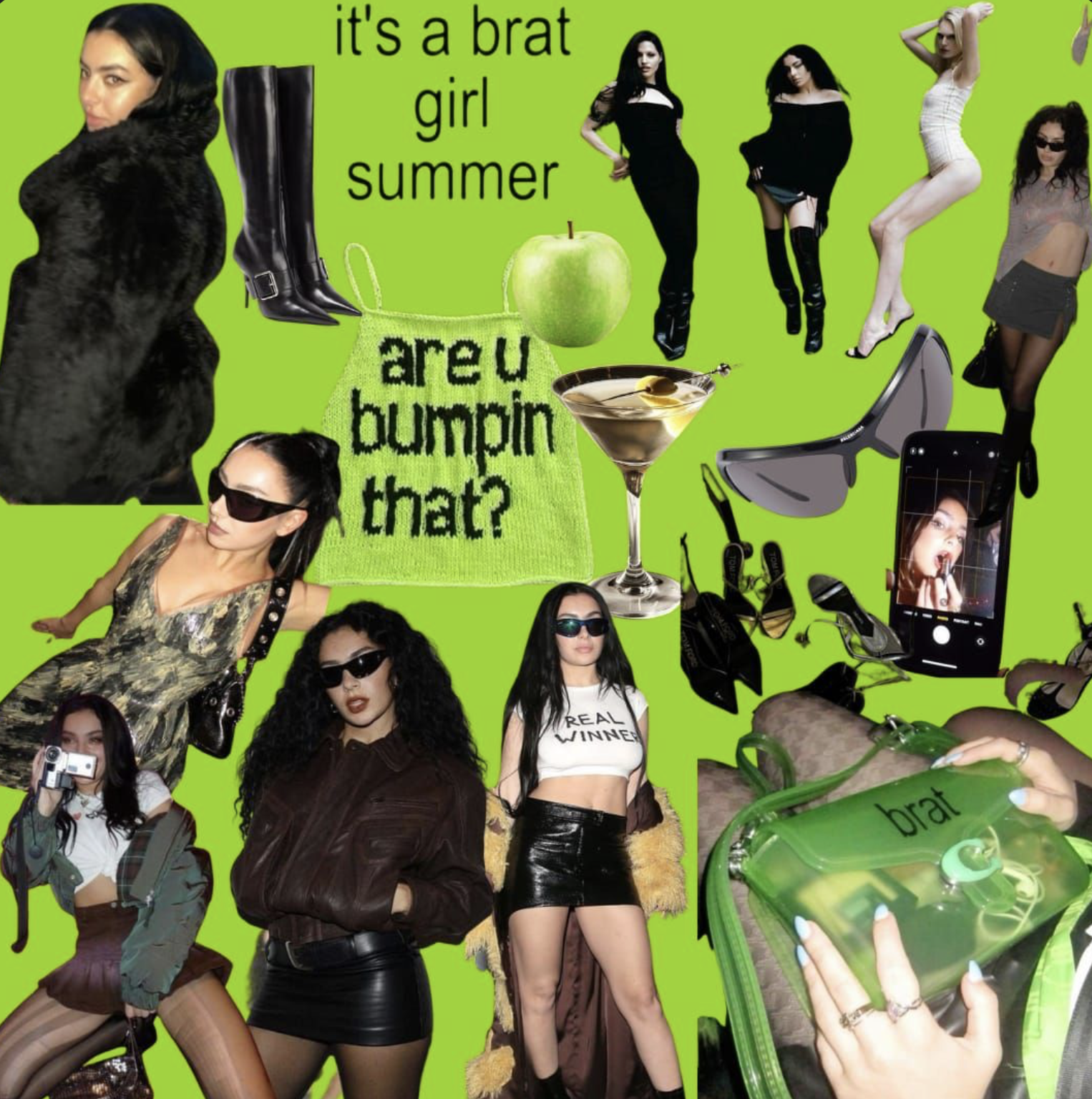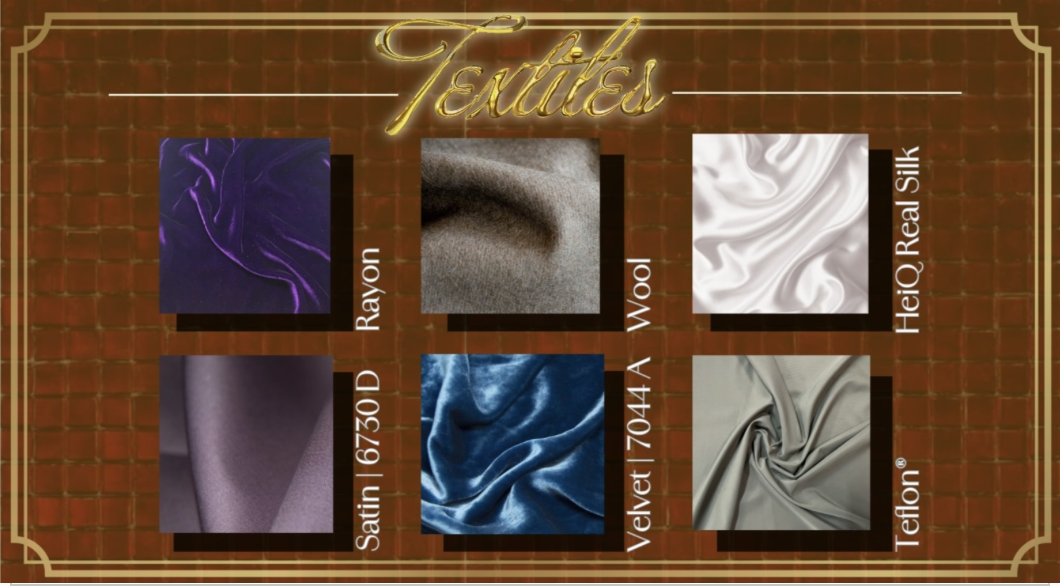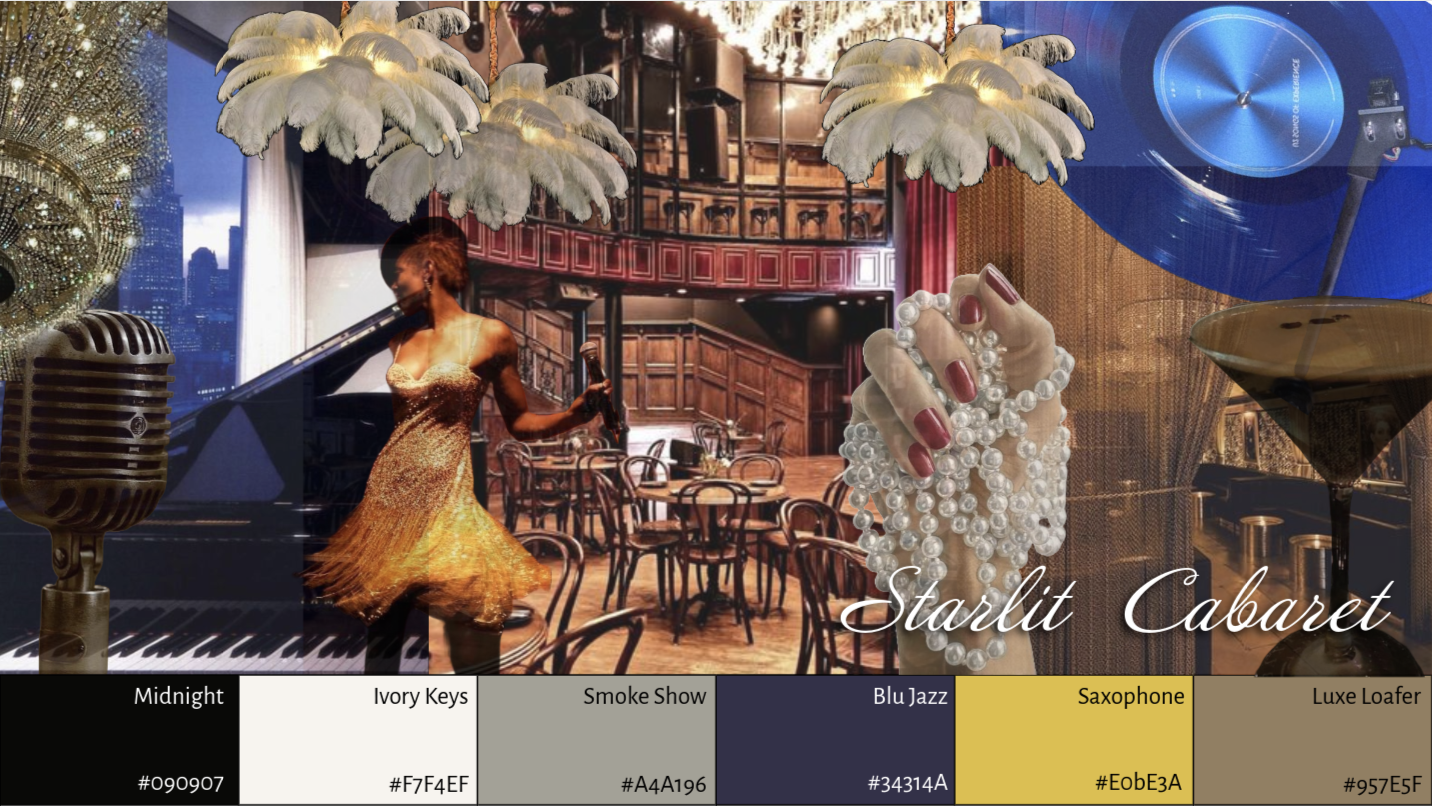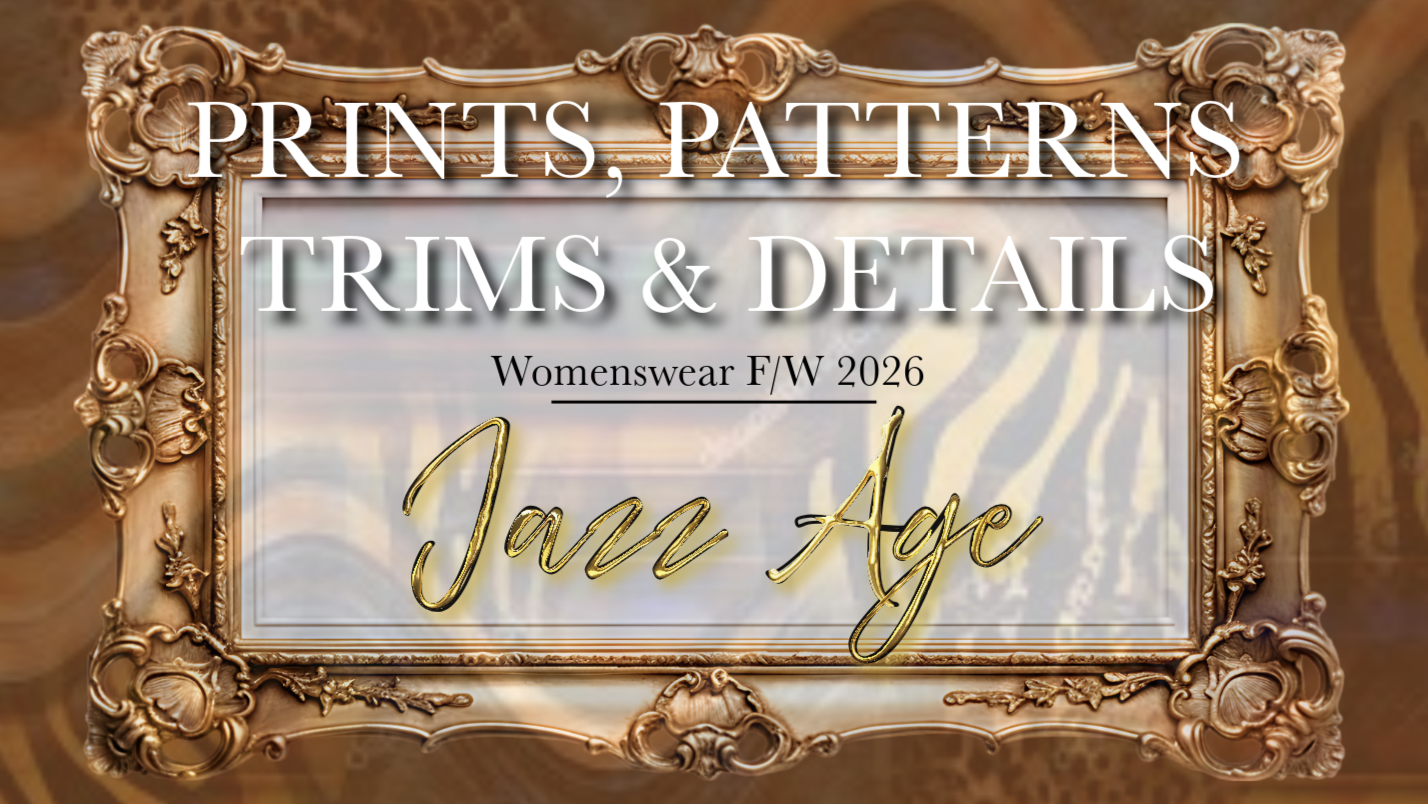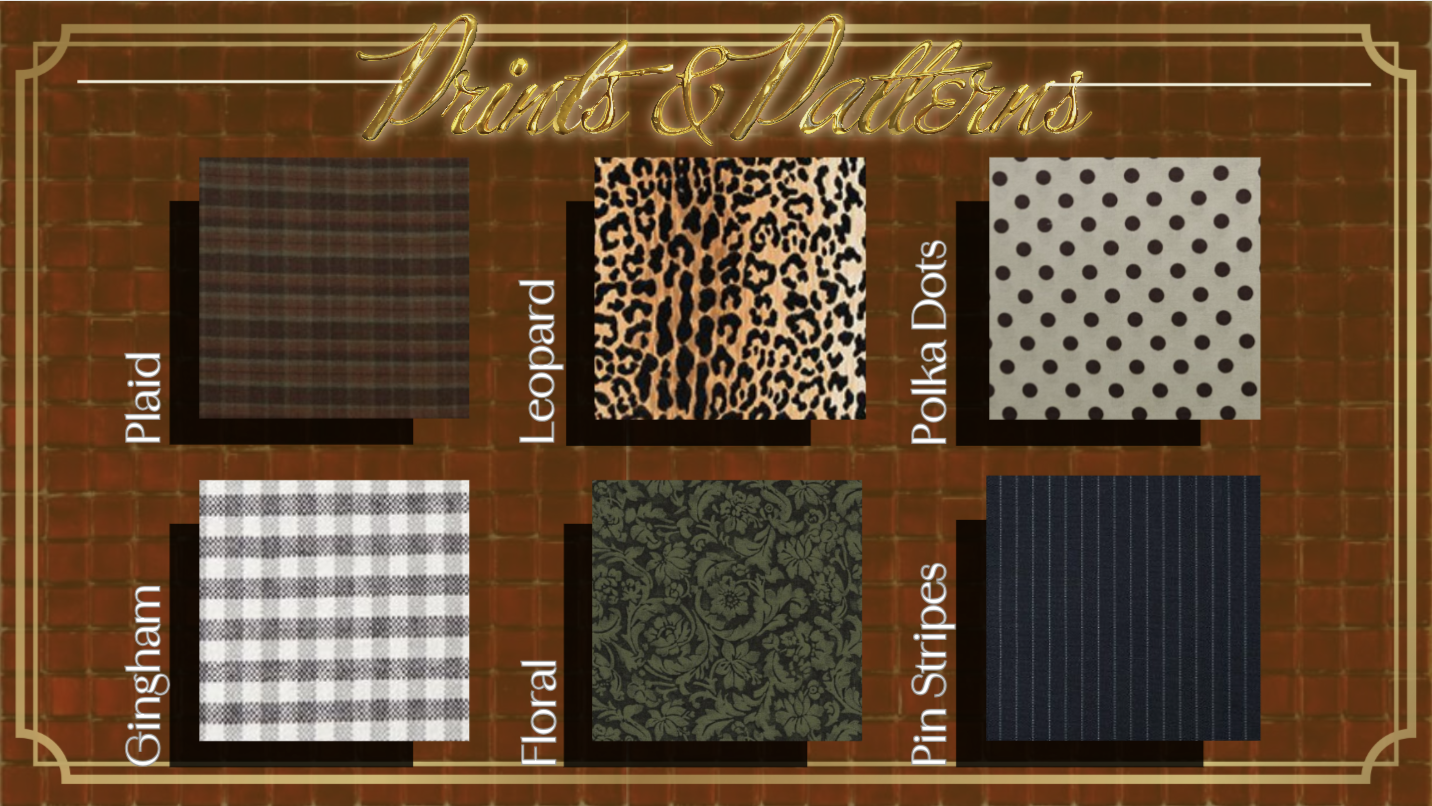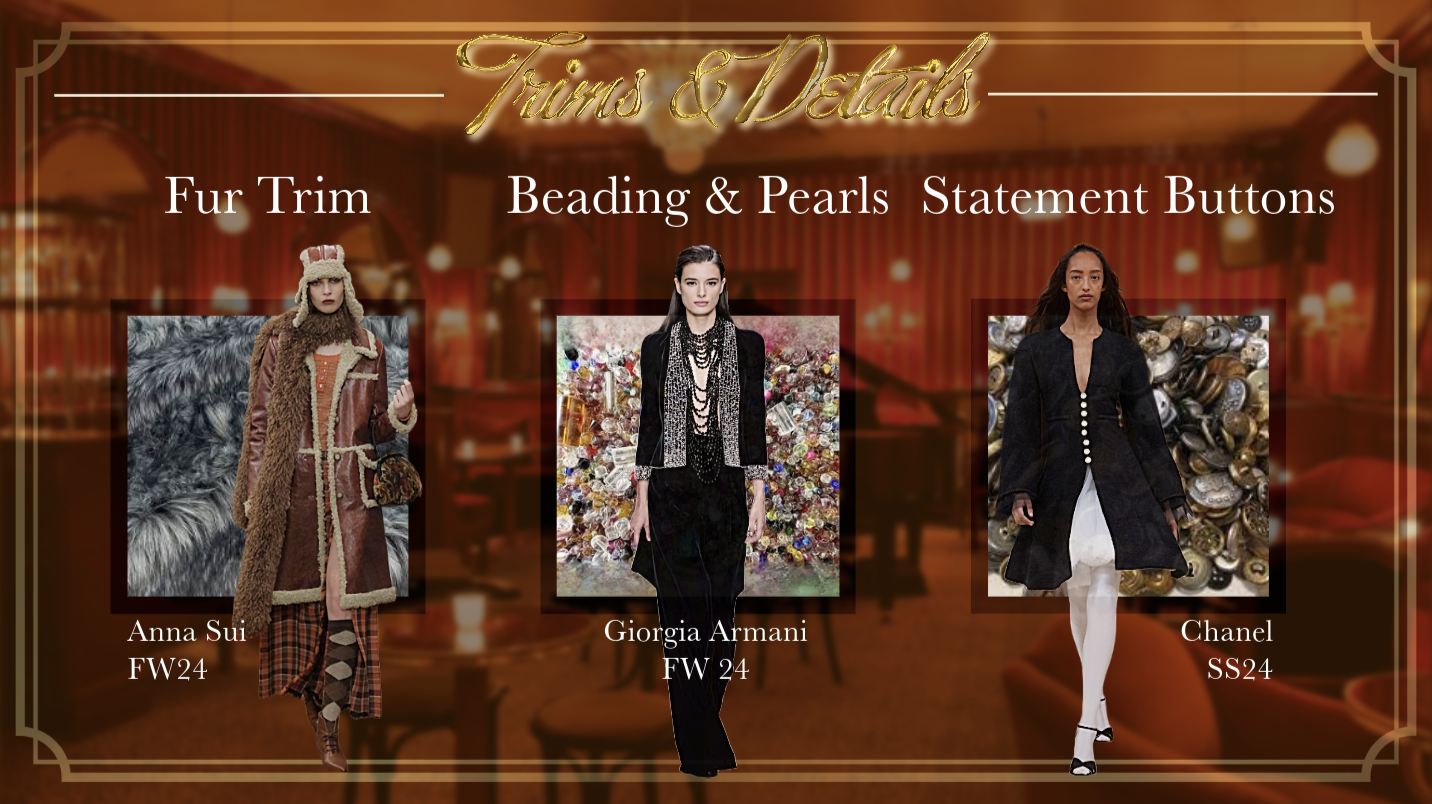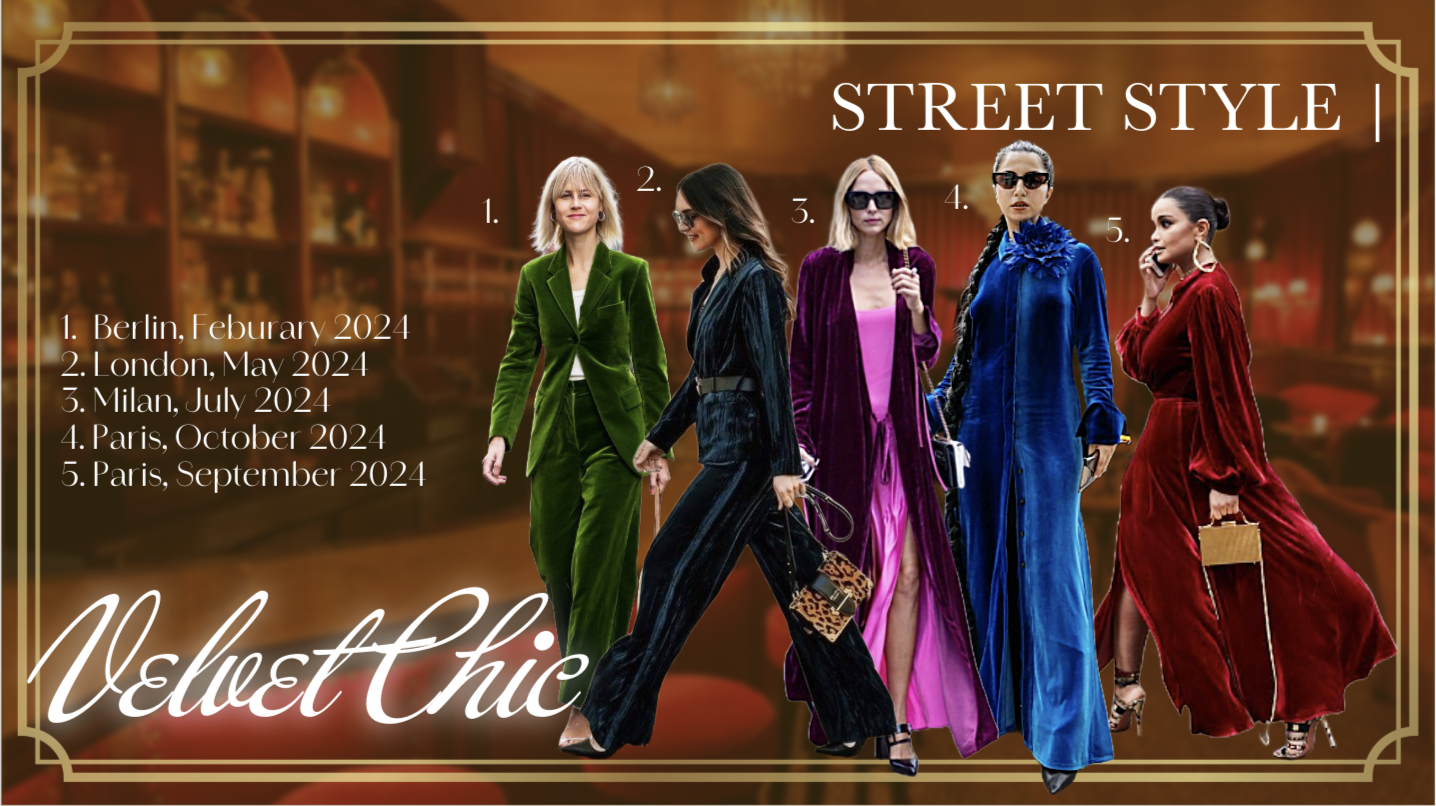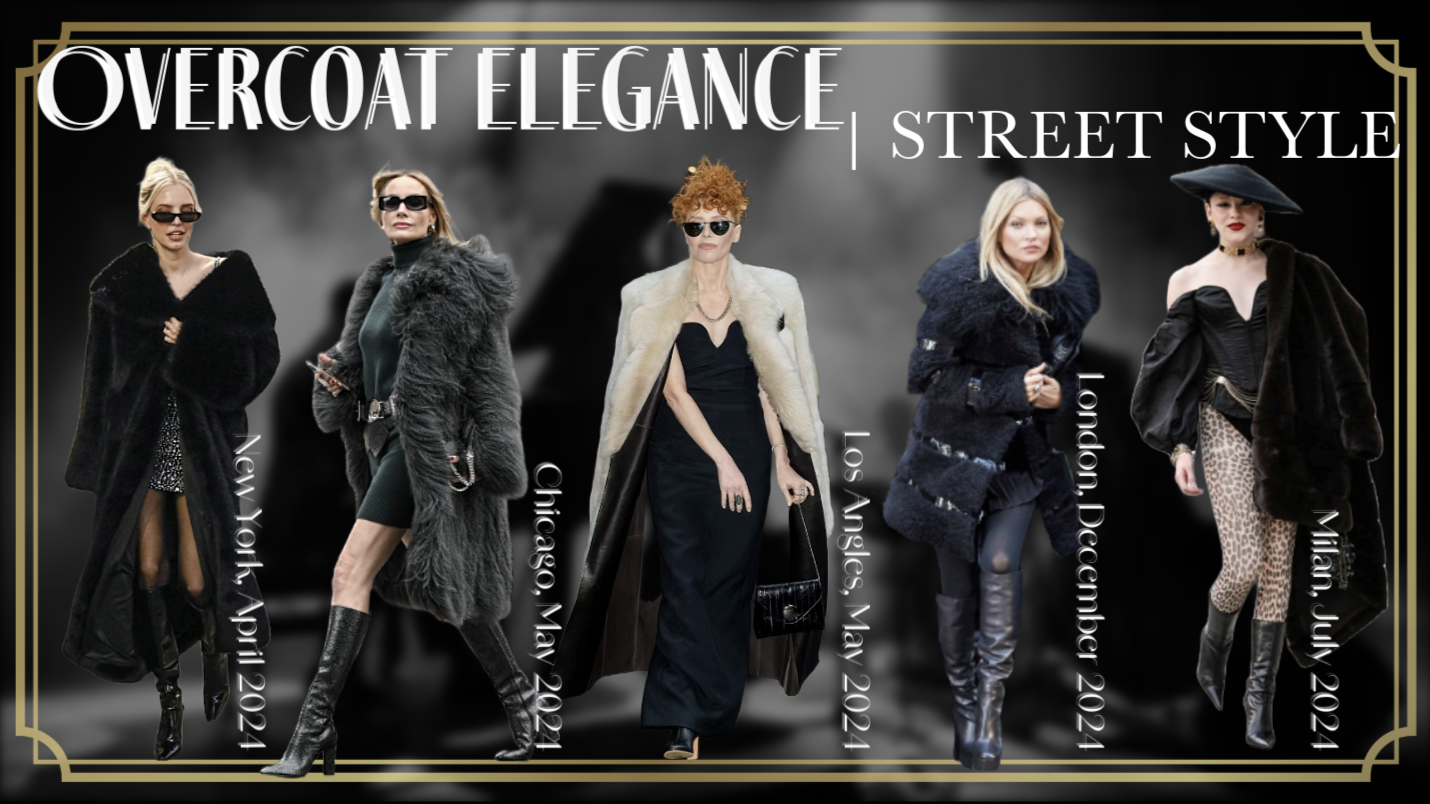
FASHION FORECAST 2026
This group project was designed through the VCUarts Fashion course Fashion Forecasting which focuses on identifying and analyzing current cultural shifts to predict consumer behavior and fashion trends.
Students learn to use trend forecasting principles, incorporating design elements like colors and fabrics, to research and simulate fashion forecasts.
This course culminates a final project presentation delivered to industry experts in Fashion Snoops.
Meet the Team
-

Quinn King
-

Reagan Pallik
-

Rhianna Holdren
-

Carmella Garner

the ask.
1. Research current trends
2. Support research through target market and influences
3. Curate a theme based on current events
4. Make a collection of fashion styles, key items, and fabrics that support your trend
5. Present forecast to industry experts fashion snoops
Photoshop
Premiere Pro
Skills
Adobe Express
Audacity

the process.
Step 1:
Brainstorming, RESEARCH & TREND FORECASTING
Brat Summer
Trump Election
chappell roan
Our team began with making connections with the current zeitgeist to the state of the fashion industry. Pulling from pop-culture, top music hits, celebrity culture, politics and the economy, we were able to cultivate a zeitgeist of 2024.
From what we gathered, many of these popularities were a reflection of American history during the 1920’s. Not only did they reflect the 1920's, through digging deeper into our research we learned that these commonalities like “rejection of modernization”, a high conservative political climate, and icons who link many of their inspirations to historical figures, were linked to events, icons, and art from the early 1900’s.
-
The Golden Lounge is our representation of the return of jazz. Reflecting on American history, we are experiencing the 1920s all over again this time with a modern flare. The aftermath of COVID-19 influenced chaos and “girls night out”, times were disruptive and clubbing was at an all time high. We are now shifting away from these routines as they are not filling the void for Generation Z. According to meta-gallup 27% of individuals ages 19-29 feel a sense of loneliness (Maese, 2024). These individuals are running away from rave culture into The Golden Lounge. An experience where individuals can escape the overstimulation of traditional nightlife and embrace a more mature and intimate setting. As we move into these next few years, Generation Z is craving social experiences that provide more meaningful outcomes, leading them to explore spaces that blend authenticity, nostalgia, and high-quality entertainment, much like jazz clubs and speakeasies taking influence from the 1920s. We predict that there will be mass acceptance of jazz clubs and speakeasies by Fall/Winter of 2026. The Golden Lounge is where the jazz age lives on.

Step 2:
CREATE A SHORT FILM THAT REFLECTS THE ZEITGEIST OF THE FORECAST
For this portion of the project, I had the task of curating a video that combines the influences and zeitgeist of our Jazz Age forecast. This was done via Adobe Express and Premiere Pro where I gathered research of the jazz scene and icons of pop-culture who connected to our theme and applied it to the culture of our era. This displayed the historic parallels emerging into our future that helped build our forecast.
-
The zeitgeist of the 1920s and 2024 share significant parallels, shaped by technological advances, cultural shifts, and economic transformation. In the 1920s, innovations like the automobile, radio, and cinema revolutionized daily life, just as today’s digital technologies, such as smartphones, AI, and virtual reality, continue to disrupt how we live and work (Dunaief, 2024). Both periods are defined by a cultural breaking of norms—whether through the rise of the flapper, the Jazz Age, and the Harlem Renaissance in the '20s, or today's focus on racial, gender, and identity liberation through movements like Black Lives Matter and LGBTQ+ rights. Economically, both decades saw prosperity followed by instability—the 1920s' "Roaring Twenties" gave way to the Great Depression, while 2024 faces inflation, inequality, and the lingering impacts of the pandemic (Dunaief, 2024). Politically, both eras experience growing polarization, with the 1920s marked by rising fascism and communism, and the 2020s by populism and political fragmentation. Finally, both periods are marked by the rise of mass media—Hollywood in the '20s and digital platforms and influencers today—shaping public identity and consumerism. Ultimately, both decades reflect moments of disruption, reinvention, and new possibilities.

Step 3:
CURATING a color story based on research
-
Saxophone and burnt brass tones reflect the opulence and glamour of Art Deco design, central to the 1920s aesthetic. These shades mirror the gleam of brass instruments like saxophones and trumpets, integral to jazz music. Psychologically, these colors symbolize wealth, success, and creativity, perfectly aligning with the Roaring Twenties' celebration of prosperity and artistic innovation. The inclusion of greens such as jade jams and dirty martini adds grounding and balance to the palette. Dark jade and olive tones evoke sophistication, vintage charm, and a connection to natural elements, such as the indoor plants and textured furnishings often seen in speakeasies. These colors also tie to the iconic green liquor bottles and cocktails like the martini, reinforcing the clandestine drinking culture of Prohibition. Neutral shades offer a clean and classic contrast to the richer tones, adding lightness and timelessness to the palette. Ivory Keys directly references piano keys, an essential element of jazz music, while Smoke Show evokes the hazy atmosphere of speakeasies filled with cigarette smoke and low lighting. These colors create visual breathing space, ensuring the design feels balanced and approachable. This palette uses color psychology to evoke both emotional depth and dynamic energy. The darker tones (blues and blacks) ground the design in mystery and elegance, while the vibrant hues (reds, golds, and greens) infuse it with vitality, creativity, and indulgence. Together, these colors capture the duality of jazz and speakeasy culture: the intimacy of secret gatherings and the boldness of artistic expression
The color story, "Happy Hour," channels the essence of jazz, speakeasy culture, and 1920s nostalgia, blending vibrant and earthy tones with bold contrasts to evoke a sophisticated yet lively ambiance.
The use of the chosen colors enhances the emotional connection, transporting viewers into a vibrant, music-filled space rich in history and indulgence.
-
The green tones evoke a sense of calm, balance, and sophistication. Jade Jams draws connections to wealth and the luxe appeal of Art Deco design, while Dirty Martini suggests a grounded, vintage charm tied to the clandestine glamour of Prohibition-era cocktails. These hues reflect the foliage and lush interiors of speakeasies, as well as iconic green liquor bottles and signage, such as the "Live Jazz" placard.
Orange and brass tones such as old fashioned and burnt brass signify opulence, tradition, and timeless elegance. These shades capture the rich glow of vintage lighting and the gleam of brass instruments central to jazz music. These colors tie directly to the warm wood paneling, glowing chandeliers, and metallic details often found in speakeasies, reinforcing their indulgent, inviting atmosphere.
Deep, bold reds evoke passion, energy, and excitement, perfectly mirroring the dynamic spirit of jazz performances and social gatherings. They also symbolize indulgence and sophistication, recalling the hues of red wine, plush interiors, and dramatic stage curtains. The palette’s use of Rhythm and Malbec reflects the decadence of Prohibition cocktails and the sultry allure of 1920s nightlife, tying into the imagery of vinyl records and vibrant music scenes.
The combination of deep greens, rich reds, and warm metallics creates a palette that balances energy with sophistication. The brass and burgundy tones mirror the vibrancy of the music, while the greens and golds ground the design in a sense of timeless luxury. The inclusion of smoke imagery and a vintage gramophone further immerses the viewer into the era, drawing attention to the sensory experience of sound, sight, and taste central to speakeasy culture. The green hues (which evoke calm and balance) contrast with the reds and metallics (which evoke energy and passion), creating visual and emotional equilibrium. This combination draws the viewer into a space that feels both exciting and sophisticated, aligning with the lively yet intimate atmosphere of a jazz club or speakeasy. The warmth of the gold and brass tones reinforces a sense of nostalgia and indulgence, inviting the viewer to step into the past and experience the glamour and rebellion of the 1920s.
The "Happy Hour" palette beautifully captures the spirit of jazz and speakeasy culture through its rich greens, passionate reds, and luxurious metallics. Each color reflects an aspect of the era, from the sultry energy of live jazz to the clandestine charm of Prohibition-era nightlife. By the specific color choices within this palette, it evokes balance, indulgence, and vibrancy, immersing the viewer in the dynamic and sophisticated world of 1920s jazz clubs.
Carmella designed this thoughtfully curated mood board and color pallet which not only mirrors the aesthetics of jazz, speakeasies, and the 1920s but also uses color psychology to immerse viewers in the era’s emotional and cultural essence.
From the moody intrigue of Midnight and Blu Jazz to the passionate vibrancy of Rhythm and the opulent luxury of Saxophone, each color tells a story of rebellion, creativity, and indulgence, bringing the spirit of the Roaring Twenties vividly to life.
The color story, "Starlit Cabaret" captures the glamour and mystique of jazz culture, Art Deco opulence, and speakeasy sophistication, drawing from the interplay of dramatic contrasts, luxurious textures, and nostalgic elegance.
Through color, it creates a rich, immersive experience that evokes indulgence, creativity, and timeless refinement.
-
The moody hues, midnight and blu jazz exude sophistication, depth, and mystery, evoking the dimly lit ambiance of speakeasies and the magnetic allure of the night. Midnight black suggests elegance and timelessness, while the deep blue adds a soulful, introspective quality tied to jazz music.These tones mirror the darkened stages of jazz clubs and the night skies over bustling cities, grounding the palette in intrigue and allure.
This bright, metallic gold of Saxophone symbolizes luxury, creativity, and prosperity, capturing the spirit of the Roaring Twenties. It draws attention to the bold and energetic aspects of jazz and nightlife culture. The hue recalls the gleaming brass of saxophones and chandeliers, central elements of jazz performances and Art Deco interiors, reinforcing the palette’s opulent vibe.
The soft, understated tones provide balance and lightness to the rich, dark hues. Ivory Keys conveys purity and timeless elegance, referencing the iconic piano keys of jazz music, while Smoke Show and Luxe Loafer suggest warmth, nostalgia, and vintage refinement. These shades evoke the atmosphere of luxurious speakeasies with plush interiors, smoky lounges, and velvet drapery, creating a tactile, indulgent environment.
The layering of textures; feathers, pearls, wood, and shimmering metallics adds to the palette’s depth, reflecting the luxurious and indulgent aesthetic of Art Deco and jazz culture. The record player and piano imagery further emphasize the musical focus, while the chandelier and martini glass nod to the sophisticated social scenes of the 1920s. Dark tones (Midnight, Blu Jazz) ground the palette in mystery and intrigue, while the gold (Saxophone) adds vibrancy and energy, and the neutrals (Ivory Keys, Smoke Show) create balance and timeless elegance. Together, these colors evoke a sense of contrast between the mysterious allure of the night and the glamour of celebration, symbolizing the duality of jazz culture: soulful introspection and spirited indulgence.
“Starlit Cabaret" is a color story that masterfully captures the glamour and mystique of jazz and speakeasy culture. The combination of moody tones, luxurious gold accents, and elegant neutrals creates a timeless and immersive aesthetic, leveraging its colors to evoke indulgence, creativity, and sophistication. This palette reflects the dynamic interplay of jazz's soulful depth and the opulent celebration of the Roaring Twenties, making it both nostalgic and modern.

Step 4:
CURATING textiles, prints, patterns, and details that will reflect our forecast
Textiles
Prints & patterns
Trims & details
Our fabrics curation was lead by Rhianna who dove into research regarding the utility of fabrics and their historical and cultural meanings behind them. What makes one fabric a night-out fabric versus a day-time fabric? This collection of fabrics was well thought out due to the collection being during the fall/winter season, tying in our Jazz Age theme.
-
The Jazz Age, was a period of bold innovation and dazzling style, where fashion reflected the dynamic cultural shifts of the time. Luxurious fabrics like rayon, wool, velvet, and satin took center stage, defining the era’s blend of accessibility and glamour. Rayon brought the elegance of silk to the masses, while wool provided structure and warmth for tailored garments. Velvet and satin, synonymous with sophistication, adorned flapper dresses, evening wear, and accessories, capturing the opulence and spirit of the Roaring Twenties. As we look ahead to Fall/Winter 2026, advancements in textile technology, such as HeiQ Real Silk and Teflon™ fabric protector, echo this timeless elegance while addressing modern demands for comfort, durability, and maintenance. This fusion of past and future celebrates the enduring allure of Jazz Age fashion in a contemporary context.
-
For Fall/Winter 2026, plaid, leopard, and polka dot patterns are set to trend, blending nostalgia with modern appeal. Plaid will gain new vibrancy through fresh color pairings and silhouettes, making it perfect for layering pieces like oversized coats and colored suits, while reflecting the season’s Jazz Age-inspired revival. Think oversized coats in jewel tones, tailored suits in vibrant checks, and layered separates that evoke the structured elegance of the Jazz Age while embracing contemporary styling. This refreshed take on plaid captures both the practicality and charm of cold-weather fashion, making it a perfect canvas for The Golden Lounge’s nostalgic yet modern aesthetic.
-
Trims and details like fur trim, beading, and statement buttons will be popular, adding a sense of elegant personalization to seasonal fashion. Fur trim will be used to accent collars, cuffs, and hems, creating a luxurious, cozy feel that aligns with the colder months and nods to vintage glamour. This detail elevates outerwear and accessories, bringing texture and warmth to classic pieces. Whether featured on structured wool coats, capes, or accessories like gloves and scarves, fur trim provides a tactile contrast that elevates classic pieces. Modern interpretations may incorporate sustainable faux fur, aligning with contemporary values while maintaining the opulence and warmth this detail is known for.
Beading offers a delicate, handcrafted touch that enhances garments with a subtle shine, perfect for nighttime-inspired looks and evening wear. Beads add a sense of artistry and nostalgia, channeling the Jazz Age while enhancing the focus on intricate, quality details. Subtle metallic or tonal beads add understated elegance, while bold, colorful embellishments create striking visual interest. This focus on craftsmanship not only adds depth and texture but also highlights the growing appreciation for quality, artisanal details in modern fashion.
Lastly, statement buttons provide bold focal points, transforming simple silhouettes with unique shapes, colors, and designs. This trend allows consumers to personalize their wardrobe with small yet impactful details, capturing a sense of individuality and sophistication that defines the season’s fashion. From oversized pearl buttons on tailored coats to geometric metallic closures on blazers, these accents allow for an element of individuality and playfulness in an otherwise minimal look.
Together, these trims and details represent a shift toward thoughtful, personalized design that balances practicality with elegance. By incorporating fur trim, beading, and statement buttons into their wardrobes, consumers can create looks that feel both nostalgic and modern, exuding sophistication and individuality. These accents not only enhance garments with texture, shine, and personality but also reflect The Golden Lounge’s timeless appeal.

Step 5:
CURATING FASHION TRENDS BASED ON RESEARCH
Our team then used this storytelling from the color pallet to the fabrics and details to build a forecasted collection of fashion trends with different themed looks that aligned with the theme of our cultural forecast. Business Deco, Velvet Chic, and overcoat elegance are three themes we felt fit right in with our forecast as they call back to 1920’s fashion in a modernized aesthetic.
-
The pantsuit, or what we’ll call the "Business Deco" first gained prominence in the 1920s Jazz Age, a period defined by cultural rebellion and self-expression. While traditionally associated with menswear, the pantsuit became a statement of empowerment for women, challenging gender norms and reflecting the progressive attitudes of the time. Its clean lines, tailored silhouettes, and Art Deco-inspired details fit perfectly with the opulence and sophistication of the era, seamlessly blending into the burgeoning jazz culture that celebrated individuality and modernity.
During the Jazz Age, the pant suit began appearing in casual streetwear as women embraced freedom and functionality in their wardrobes. Influenced by the Art Deco aesthetic, designs featured sharp tailoring, high-waisted trousers, and elegant lapels, often complemented by bold patterns, luxurious fabrics, and striking accessories. The look was a favorite among women frequenting jazz clubs and speakeasies, pairing practicality with effortless style. This emerging trend was emblematic of the Jazz Age's broader societal shift, one that valued liberation, innovation, and breaking conventions.
As the 2020s experience a cultural renaissance reminiscent of the Jazz Age, "Business Deco" is making a striking comeback in street fashion. With the resurgence of jazz culture, contemporary pant suits draw inspiration from their 1920s counterparts, merging vintage elements with modern sensibilities. Today's versions feature oversized tailoring, exaggerated shoulders, and bold, monochromatic hues such as mustard yellow, ivory white, and muted grays, reflecting the Art Deco era’s elegance and grandeur. These designs also incorporate playful updates, like soft, fluid fabrics, asymmetrical cuts, and retro-inspired accessories, adding a fresh, approachable edge (Kim, 2024).
The Business Deco Look is perfectly positioned to dominate contemporary fashion as it aligns with current preferences for gender-fluid designs, versatile wardrobe staples, and vintage-inspired aesthetics. Just as it did in the Jazz Age, the pantsuit offers wearers a unique blend of sophistication and comfort. Its adaptability, from polished professional settings to relaxed street style, ensures its longevity in modern wardrobes. Paired with the ongoing resurgence of jazz clubs, speakeasy-inspired nightlife, and a renewed appreciation for Art Deco design, the pantsuit stands as a sartorial symbol of creativity, rebellion, and timeless elegance.
-
The "Velvet Chic" aesthetic captures the luxurious and timeless appeal of velvet in modern street style, blending vintage elegance with contemporary trends. Velvet, a fabric historically associated with royalty and opulence, has been reimagined for the modern era, offering a sophisticated yet bold statement in fashion. With its rich texture and vibrant hues, velvet is making a striking comeback, drawing inspiration from classic 1920s Art Deco glamour and seamlessly integrating into today’s fashion-forward wardrobes.
Velvet has long been a symbol of luxury, prominently featured in evening wear during the 1920s Jazz Age, an era celebrated for its indulgence and sophistication. The fabrics’ softness and natural sheen made it a popular choice for elegant dresses and accessories, often seen in speakeasies and glamorous social gatherings. Its ability to reflect light and showcase depth in color made it synonymous with wealth and status, a timeless association carried into its modern resurgence. Today, "Velvet Chic" builds upon its historical significance, bringing the fabric into the realm of street style with contemporary silhouettes and bold design choices. Modern iterations of velvet clothing emphasize versatility, allowing it to transition effortlessly from formal to casual settings while maintaining its luxurious appeal. Tailored suits, like the green and navy examples shown, velvet is being used for sharp, tailored silhouettes. These suits reflect a balance of structure and softness, perfect for those looking to make a polished yet dramatic statement. The flowing velvet dresses in deep burgundy and jewel-toned gowns draw directly from 1920s glamour, exuding elegance and sophistication. These pieces are perfect for evening events or streetwear styled with edgy accessories. Vibrant hues like emerald green, sapphire blue, amethyst purple, and ruby red dominate this aesthetic, showcasing velvet’s ability to elevate color intensity. Velvet’s texture and sheen evoke feelings of comfort, luxury, and indulgence, making it an emotionally appealing fabric. The rich jewel tones associated with velvet are also psychologically linked to feelings of wealth, power, and creativity, aligning perfectly with its high-fashion status (Rohan, 2023).
The resurgence of velvet aligns with contemporary fashion’s focus on vintage revival and material richness. Velvet offers a tactile, opulent quality that modern consumers find appealing in a world increasingly defined by fast fashion. Its ability to merge historical elegance with modern versatility makes it a favorite for both runway and street style.
-
The "Overcoat Elegance" aesthetic highlights the timeless sophistication of luxurious outerwear as a centerpiece in modern street style. This trend celebrates the revival of statement coats, particularly fur, faux fur, and textured overcoats, combining vintage glamour with contemporary edge. Drawing inspiration from the 1920s Art Deco era and classic Hollywood, this look reflects the power of outerwear to elevate any ensemble into a bold fashion statement.
The 1920s and early 20th century celebrated outerwear as a symbol of luxury and elegance. Overcoats in this period were crafted from materials like fur, wool, and velvet, often worn over evening gowns or tailored ensembles to exude sophistication. Women attending jazz clubs or speakeasies would don fur stoles, capes, or feathered accents, completing their looks with an air of indulgence and poise. This emphasis on texture and layering has influenced modern interpretations of overcoats as both practical and extravagant wardrobe essentials.
Today, "Overcoat Elegance" reflects this historical opulence, reinterpreted with modern fashion sensibilities. Street style has embraced bold overcoats as key pieces that blend vintage charm with contemporary edge. Luxurious textures like faux fur dominate the look, offering warmth, drama, and a cruelty-free nod to vintage fur trends. Structured yet voluminous coats create a sense of grandeur and confidence, particularly when paired with sleek boots or fitted clothing underneath. Black, charcoal, and deep jewel tones like emerald and sapphire highlight the opulent nature of the look, reminiscent of old Hollywood glamour.
Outerwear is becoming increasingly central to modern wardrobes, as people seek practical yet striking statement pieces for the colder months. The resurgence of overcoats aligns with a broader desire for timeless, investment-worthy items that convey both functionality and luxury. Paired with modern styling, these coats serve as transitional pieces, working for formal occasions, casual streetwear, and everything in between.
Overall, the "Overcoat Elegance” aesthetic evokes feelings of power, protection, and confidence. The luxurious textures of fur and rich fabrics symbolize status and indulgence, while dark, monochromatic tones communicate authority and sophistication. The oversized silhouettes offer both physical and psychological comfort, enveloping the wearer in a sense of security while maintaining a commanding presence.





